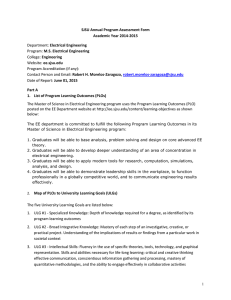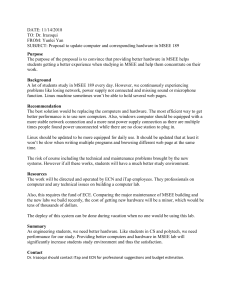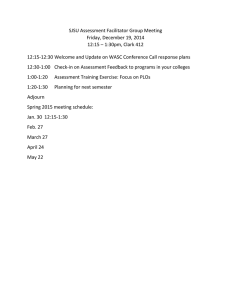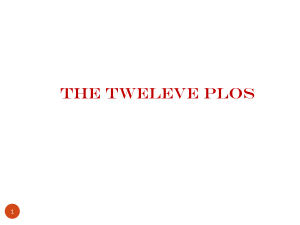SJSU Annual Program Assessment Form Academic Year 2013-2014 Electrical Engineering M.S. Electrical Engineering
advertisement
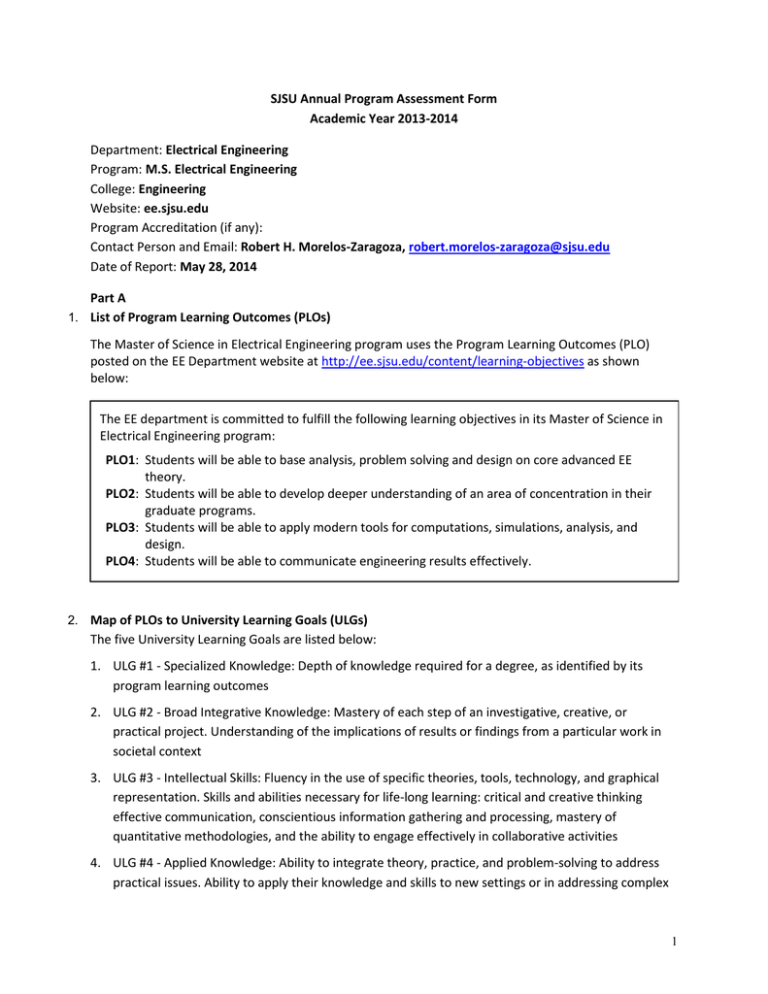
SJSU Annual Program Assessment Form Academic Year 2013-2014 Department: Electrical Engineering Program: M.S. Electrical Engineering College: Engineering Website: ee.sjsu.edu Program Accreditation (if any): Contact Person and Email: Robert H. Morelos-Zaragoza, robert.morelos-zaragoza@sjsu.edu Date of Report: May 28, 2014 Part A 1. List of Program Learning Outcomes (PLOs) The Master of Science in Electrical Engineering program uses the Program Learning Outcomes (PLO) posted on the EE Department website at http://ee.sjsu.edu/content/learning-objectives as shown below: The EE department is committed to fulfill the following learning objectives in its Master of Science in Electrical Engineering program: PLO1: Students will be able to base analysis, problem solving and design on core advanced EE theory. PLO2: Students will be able to develop deeper understanding of an area of concentration in their graduate programs. PLO3: Students will be able to apply modern tools for computations, simulations, analysis, and design. PLO4: Students will be able to communicate engineering results effectively. 2. Map of PLOs to University Learning Goals (ULGs) The five University Learning Goals are listed below: 1. ULG #1 - Specialized Knowledge: Depth of knowledge required for a degree, as identified by its program learning outcomes 2. ULG #2 - Broad Integrative Knowledge: Mastery of each step of an investigative, creative, or practical project. Understanding of the implications of results or findings from a particular work in societal context 3. ULG #3 - Intellectual Skills: Fluency in the use of specific theories, tools, technology, and graphical representation. Skills and abilities necessary for life-long learning: critical and creative thinking effective communication, conscientious information gathering and processing, mastery of quantitative methodologies, and the ability to engage effectively in collaborative activities 4. ULG #4 - Applied Knowledge: Ability to integrate theory, practice, and problem-solving to address practical issues. Ability to apply their knowledge and skills to new settings or in addressing complex 1 problems. The ability to work productively as individuals and in groups 5. ULG #5 - Social and Global Responsibilities: Ability to act intentionally and ethically to address a global or local problem in an informed manner with a multicultural and historical perspective and a clear understanding of societal and civic responsibilities. Diverse and global perspectives through engagement with the multidimensional SJSU community The mapping of MSEE PLOs to the University Learning Goals is shown in the table below. MSEE Program Learning Objectives (PLOs) PLO1: Ability to base analysis, problem solving and design on core advanced EE theory PLO2: Ability to develop deeper understanding of an area of concentration in their graduate programs PLO3: Ability to apply modern tools for computations, simulations, analysis, and design PLO4: Ability to communicate engineering results effectively 1 X 2 X X X ULGs 3 4 X X X X X 5 X X X X 3. Alignment – Matrix of PLOs to Courses The levels of attainment of courses to the MSEE Program Learning/Student Outcomes are shown in the table below. In the table, the numbers (1 to 5) represent the levels of support such that blank (or 0) means "no support," 1 is minimum support and 5 is the highest support Program Outcomes versus Courses EE 295 / EE 210 EE 221 EE 250 ENGR 200W PLO1 5 5 5 PLO2 PLO3 4 3 PLO4 4 Comprehensive Exam1 EE 297A/B 5 4 5 5 EE 299A/B 4 5 5 1 List of courses covered in the comprehensive exam: EE210, EE221, EE223, EE224, EE250, EE251, EE253, EE270, EE271, EE281, EE283. 4. Planning – Assessment Schedule The overall data collection (C), evaluation (D), and implementation (I) schedule for the EE graduate program is shown in the figure below. The figure only shows the schedule for the assessment of the Program Educational Objectives. 2 ↓Semester Program Start Semester of End of Program ↓ PO F-10 S-11 F-11 S-12 F-12 S-13 F-13 S-14 F-14 S-15 1 C D I C D I C D I C C D I C D I C D I C D I C D I C D C D I C D I C 2 3 4 The Overall Program Assessment Schedule 5. Student Experience The current set of MSEE Program Educational Objectives is available in the university catalog and posted on the EE Department website at http://ee.sjsu.edu/content/learning-objectives The Program Educational Objectives are determined and evaluated through consultation involving four core constituents: Students, Alumni, Industry, and Faculty. Students have limited knowledge of the program outcomes. Communication is occasional and informal, left to individual faculty or advisors. Part B 6. Graduation Rates for Total, Non URM and URM students (per program and degree) Academic Programs Electrical Engineering First-time Freshmen: 6 Year Graduation Rates New UG Transfers: 3 Year Graduation Rates Grads : 3 Year Graduation Rates Fall 2007 Cohort Fall 2010 Cohort Fall 2010 Cohort Entering % Grad Entering % Grad Entering % Grad Total 46 45.7% 39 43.6% 157 73.9% URM 11 18.2% 5 0.0% 5 80.0% Non-URM 27 51.9% 24 50.0% 31 41.9% Other 8 62.5% 10 50.0% 121 81.8% 7. Headcounts of program majors and new students (per program and degree) Fall 2013 New Students Electrical Engineering Degree 1st Fr. UG Transf New Creds Total 92 98 0 BS 92 98 MS 0 0 Cont. Students Total 1st Grads 192 UGs Creds Grads UGs Creds Grads 345 0 213 535 0 405 0 0 345 0 0 535 0 0 0 192 0 0 213 0 0 405 3 8. SFR and average section size (per program) Fall 2013 Student to Faculty Ratio (SFR) 22.5 Average Headcount per Section Lower Division 45.4 39.4 Upper Division 22.9 37.8 Graduate Division 20.5 32.0 Course Prefix Course Level EE - Electrical Engineering Total 34.9 9. Percentage of tenured/tenure-track instructional faculty (per department) Fall 2013 Electrical Engineering % Tenured/Prob Tenured Probationary Temp Lecturer 62.0% 9.175 7.707 3.421 Part C 10. Closing the Loop/Recommended Actions ∙ Develop rubrics for each assessed outcome for all core courses, comprehensive exam, and the project/thesis courses ∙ Develop a student database for student advising ∙ Continue data collection (C), analysis of assessment results (D), and implementation of recommended changes (I) as scheduled ∙ Invite industry representatives and working engineers to attend MSEE project/thesis presentations ∙ Modify the number of core courses to two and add a mandatory area course 11. Assessment Data Data for this report is based on a PLO report prepared for WASC in Fall 2011. MSEE project reports, theses and comprehensive exams are available from the EE department upon request. 12. Analysis The EE297A course now includes lectures on technical report preparation, proper use of references, presentation skills and invited lectures. Rubrics have not yet been implemented in full. In particular, some data of final project courses EE297A/B (which most students take) rely only grades. The department has yet to implement a proper direct-assessment process for the MSEE program. 13. Proposed changes and goals (if any) ∙ Include proper course learning objectives using Bloom’s taxonomy in all MSEE program courses ∙ Perform direct assessment in core courses, using samples of student work ∙ Define new student outcomes and redefine program educational objectives (which are currently stated as outcomes) for the MSEE program 4
